ITCO425: System Architecture, Integration, and Implementation Report
VerifiedAdded on 2022/08/22
|10
|1862
|23
Report
AI Summary
This report provides a detailed overview of system architecture and integration, focusing on the implementation framework. It encompasses various aspects of system development, including testing activities, such as defining scope, assessing testability, and designing test cases. The report also delves into final migration activities, emphasizing the importance of migration plans and the transfer of data and functionality. Training activities are discussed, highlighting the need for trainers to be knowledgeable and the use of incentives to encourage employee participation. Project closeout activities, such as meetings and report compilation, are outlined, along with starting and completion dates. The report concludes with lessons learned, emphasizing the importance of starting small, implementing changes incrementally, and ensuring thorough testing. References to relevant literature are also included.
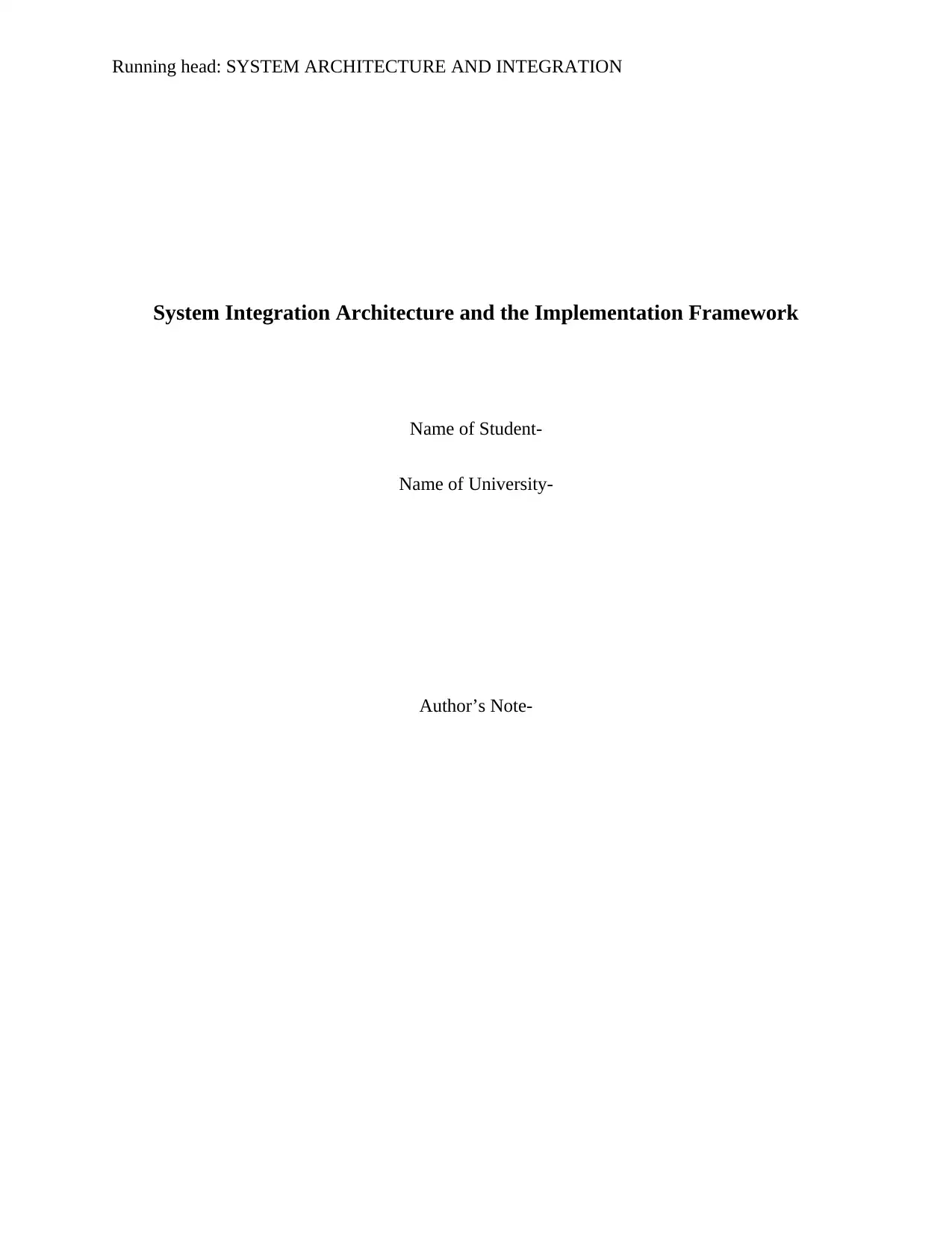
Running head: SYSTEM ARCHITECTURE AND INTEGRATION
System Integration Architecture and the Implementation Framework
Name of Student-
Name of University-
Author’s Note-
System Integration Architecture and the Implementation Framework
Name of Student-
Name of University-
Author’s Note-
Paraphrase This Document
Need a fresh take? Get an instant paraphrase of this document with our AI Paraphraser
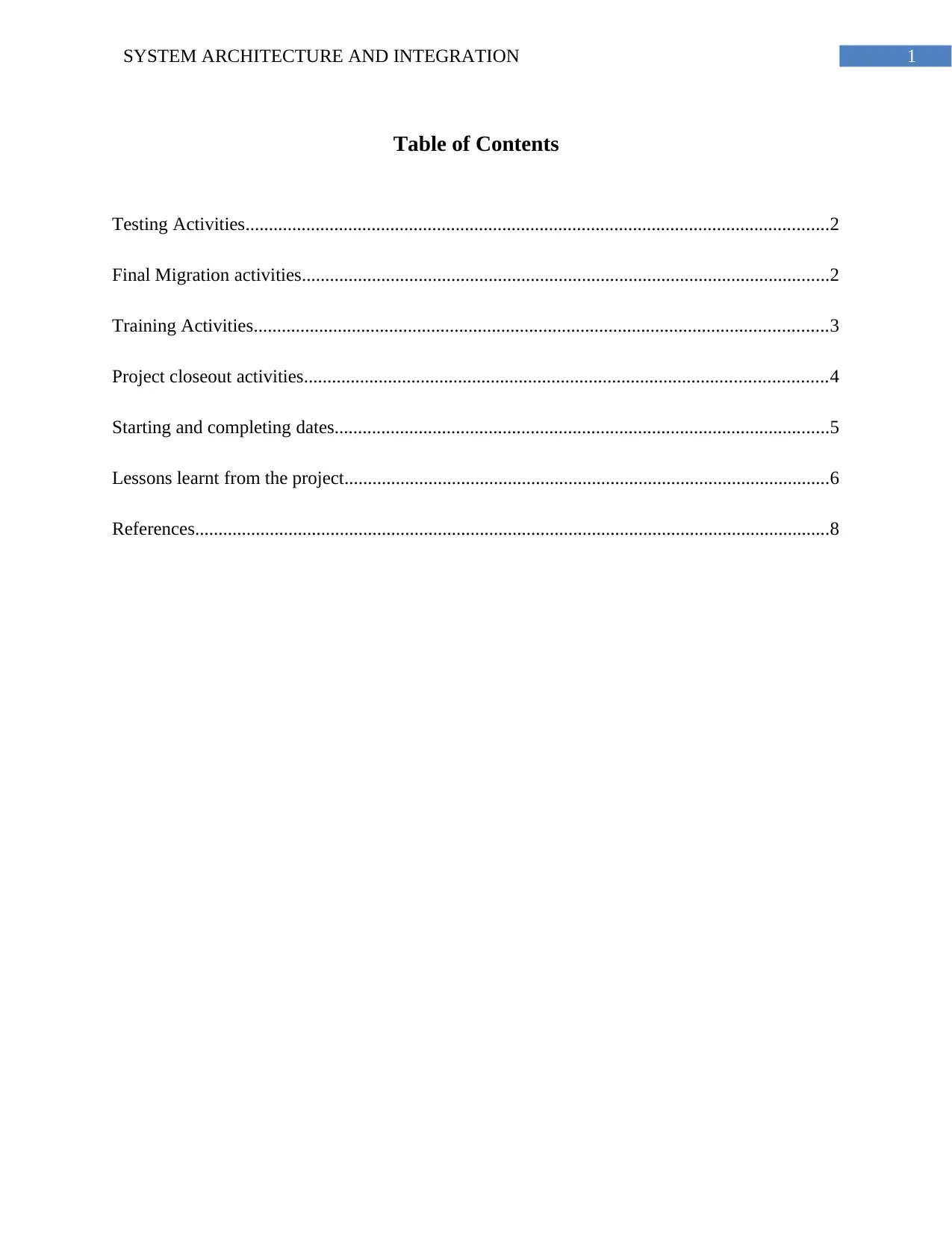
1SYSTEM ARCHITECTURE AND INTEGRATION
Table of Contents
Testing Activities.............................................................................................................................2
Final Migration activities.................................................................................................................2
Training Activities...........................................................................................................................3
Project closeout activities................................................................................................................4
Starting and completing dates..........................................................................................................5
Lessons learnt from the project........................................................................................................6
References........................................................................................................................................8
Table of Contents
Testing Activities.............................................................................................................................2
Final Migration activities.................................................................................................................2
Training Activities...........................................................................................................................3
Project closeout activities................................................................................................................4
Starting and completing dates..........................................................................................................5
Lessons learnt from the project........................................................................................................6
References........................................................................................................................................8
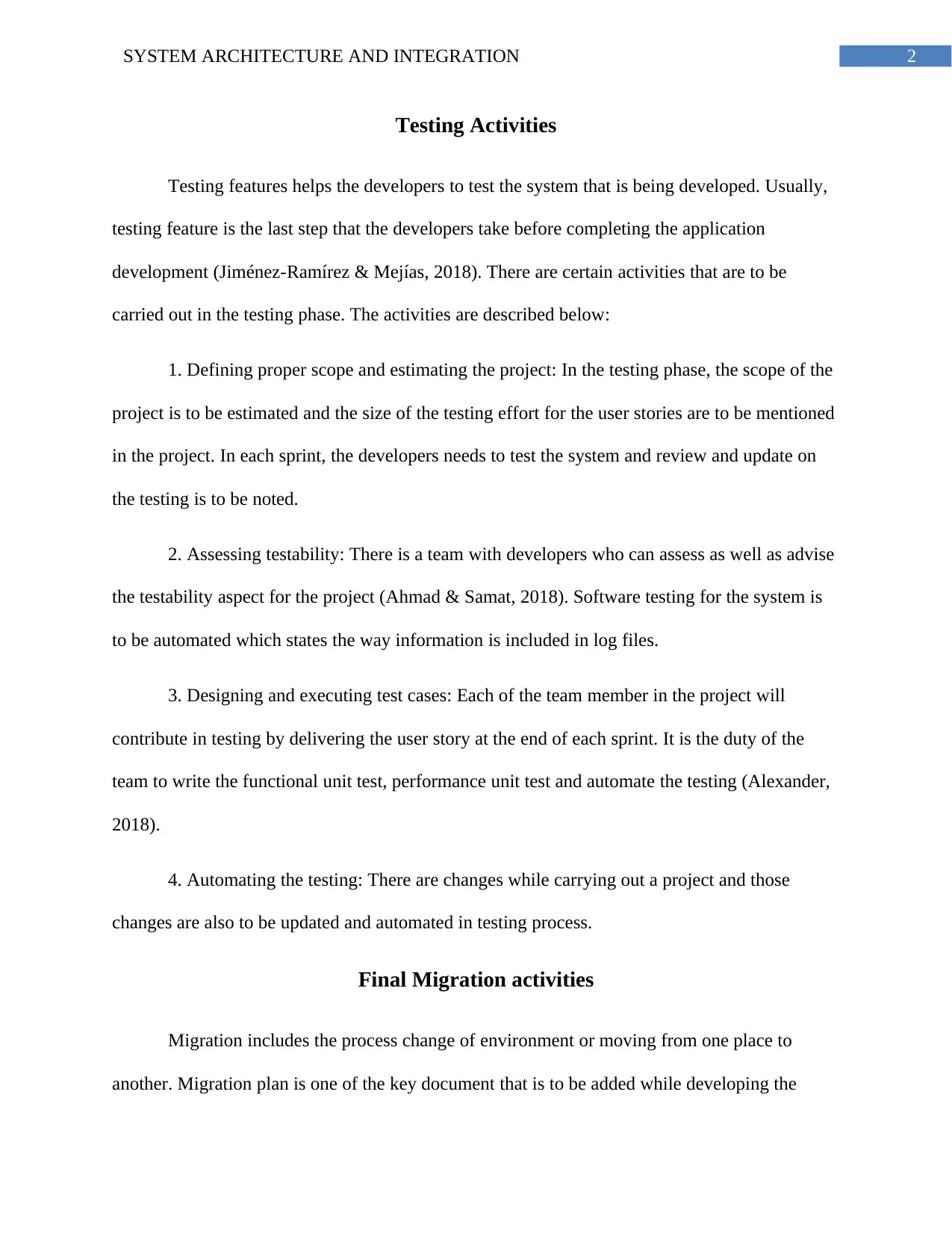
2SYSTEM ARCHITECTURE AND INTEGRATION
Testing Activities
Testing features helps the developers to test the system that is being developed. Usually,
testing feature is the last step that the developers take before completing the application
development (Jiménez-Ramírez & Mejías, 2018). There are certain activities that are to be
carried out in the testing phase. The activities are described below:
1. Defining proper scope and estimating the project: In the testing phase, the scope of the
project is to be estimated and the size of the testing effort for the user stories are to be mentioned
in the project. In each sprint, the developers needs to test the system and review and update on
the testing is to be noted.
2. Assessing testability: There is a team with developers who can assess as well as advise
the testability aspect for the project (Ahmad & Samat, 2018). Software testing for the system is
to be automated which states the way information is included in log files.
3. Designing and executing test cases: Each of the team member in the project will
contribute in testing by delivering the user story at the end of each sprint. It is the duty of the
team to write the functional unit test, performance unit test and automate the testing (Alexander,
2018).
4. Automating the testing: There are changes while carrying out a project and those
changes are also to be updated and automated in testing process.
Final Migration activities
Migration includes the process change of environment or moving from one place to
another. Migration plan is one of the key document that is to be added while developing the
Testing Activities
Testing features helps the developers to test the system that is being developed. Usually,
testing feature is the last step that the developers take before completing the application
development (Jiménez-Ramírez & Mejías, 2018). There are certain activities that are to be
carried out in the testing phase. The activities are described below:
1. Defining proper scope and estimating the project: In the testing phase, the scope of the
project is to be estimated and the size of the testing effort for the user stories are to be mentioned
in the project. In each sprint, the developers needs to test the system and review and update on
the testing is to be noted.
2. Assessing testability: There is a team with developers who can assess as well as advise
the testability aspect for the project (Ahmad & Samat, 2018). Software testing for the system is
to be automated which states the way information is included in log files.
3. Designing and executing test cases: Each of the team member in the project will
contribute in testing by delivering the user story at the end of each sprint. It is the duty of the
team to write the functional unit test, performance unit test and automate the testing (Alexander,
2018).
4. Automating the testing: There are changes while carrying out a project and those
changes are also to be updated and automated in testing process.
Final Migration activities
Migration includes the process change of environment or moving from one place to
another. Migration plan is one of the key document that is to be added while developing the
⊘ This is a preview!⊘
Do you want full access?
Subscribe today to unlock all pages.

Trusted by 1+ million students worldwide
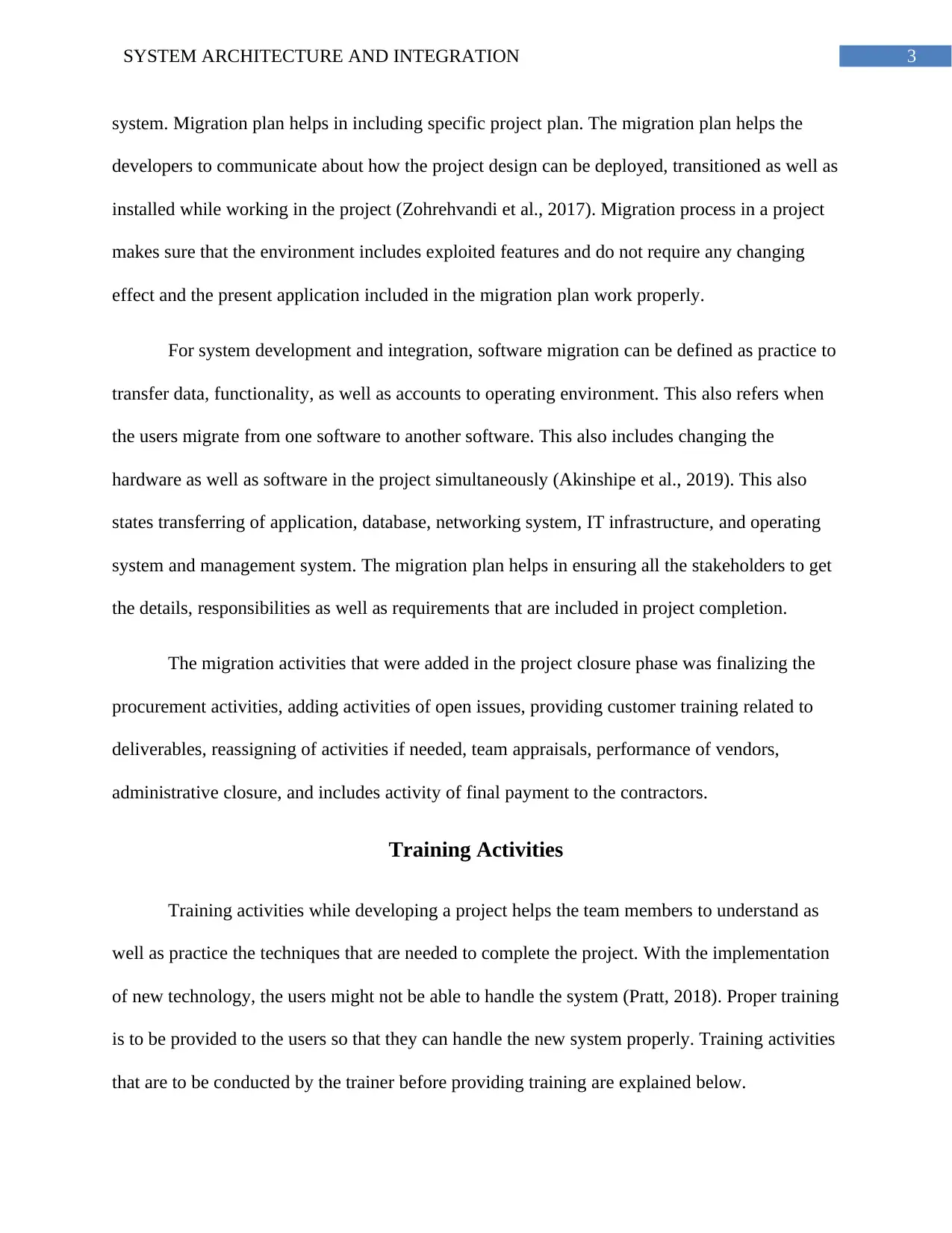
3SYSTEM ARCHITECTURE AND INTEGRATION
system. Migration plan helps in including specific project plan. The migration plan helps the
developers to communicate about how the project design can be deployed, transitioned as well as
installed while working in the project (Zohrehvandi et al., 2017). Migration process in a project
makes sure that the environment includes exploited features and do not require any changing
effect and the present application included in the migration plan work properly.
For system development and integration, software migration can be defined as practice to
transfer data, functionality, as well as accounts to operating environment. This also refers when
the users migrate from one software to another software. This also includes changing the
hardware as well as software in the project simultaneously (Akinshipe et al., 2019). This also
states transferring of application, database, networking system, IT infrastructure, and operating
system and management system. The migration plan helps in ensuring all the stakeholders to get
the details, responsibilities as well as requirements that are included in project completion.
The migration activities that were added in the project closure phase was finalizing the
procurement activities, adding activities of open issues, providing customer training related to
deliverables, reassigning of activities if needed, team appraisals, performance of vendors,
administrative closure, and includes activity of final payment to the contractors.
Training Activities
Training activities while developing a project helps the team members to understand as
well as practice the techniques that are needed to complete the project. With the implementation
of new technology, the users might not be able to handle the system (Pratt, 2018). Proper training
is to be provided to the users so that they can handle the new system properly. Training activities
that are to be conducted by the trainer before providing training are explained below.
system. Migration plan helps in including specific project plan. The migration plan helps the
developers to communicate about how the project design can be deployed, transitioned as well as
installed while working in the project (Zohrehvandi et al., 2017). Migration process in a project
makes sure that the environment includes exploited features and do not require any changing
effect and the present application included in the migration plan work properly.
For system development and integration, software migration can be defined as practice to
transfer data, functionality, as well as accounts to operating environment. This also refers when
the users migrate from one software to another software. This also includes changing the
hardware as well as software in the project simultaneously (Akinshipe et al., 2019). This also
states transferring of application, database, networking system, IT infrastructure, and operating
system and management system. The migration plan helps in ensuring all the stakeholders to get
the details, responsibilities as well as requirements that are included in project completion.
The migration activities that were added in the project closure phase was finalizing the
procurement activities, adding activities of open issues, providing customer training related to
deliverables, reassigning of activities if needed, team appraisals, performance of vendors,
administrative closure, and includes activity of final payment to the contractors.
Training Activities
Training activities while developing a project helps the team members to understand as
well as practice the techniques that are needed to complete the project. With the implementation
of new technology, the users might not be able to handle the system (Pratt, 2018). Proper training
is to be provided to the users so that they can handle the new system properly. Training activities
that are to be conducted by the trainer before providing training are explained below.
Paraphrase This Document
Need a fresh take? Get an instant paraphrase of this document with our AI Paraphraser
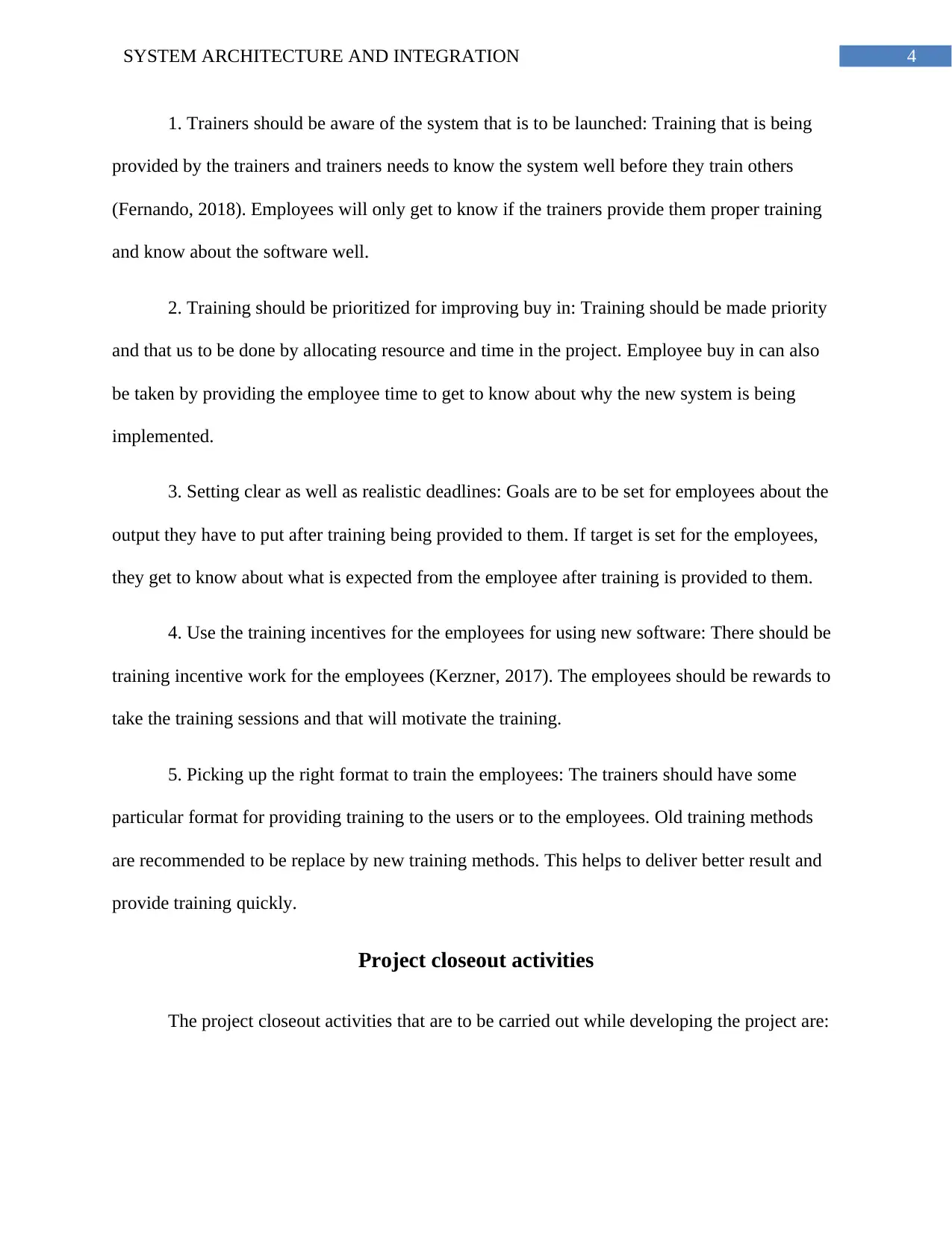
4SYSTEM ARCHITECTURE AND INTEGRATION
1. Trainers should be aware of the system that is to be launched: Training that is being
provided by the trainers and trainers needs to know the system well before they train others
(Fernando, 2018). Employees will only get to know if the trainers provide them proper training
and know about the software well.
2. Training should be prioritized for improving buy in: Training should be made priority
and that us to be done by allocating resource and time in the project. Employee buy in can also
be taken by providing the employee time to get to know about why the new system is being
implemented.
3. Setting clear as well as realistic deadlines: Goals are to be set for employees about the
output they have to put after training being provided to them. If target is set for the employees,
they get to know about what is expected from the employee after training is provided to them.
4. Use the training incentives for the employees for using new software: There should be
training incentive work for the employees (Kerzner, 2017). The employees should be rewards to
take the training sessions and that will motivate the training.
5. Picking up the right format to train the employees: The trainers should have some
particular format for providing training to the users or to the employees. Old training methods
are recommended to be replace by new training methods. This helps to deliver better result and
provide training quickly.
Project closeout activities
The project closeout activities that are to be carried out while developing the project are:
1. Trainers should be aware of the system that is to be launched: Training that is being
provided by the trainers and trainers needs to know the system well before they train others
(Fernando, 2018). Employees will only get to know if the trainers provide them proper training
and know about the software well.
2. Training should be prioritized for improving buy in: Training should be made priority
and that us to be done by allocating resource and time in the project. Employee buy in can also
be taken by providing the employee time to get to know about why the new system is being
implemented.
3. Setting clear as well as realistic deadlines: Goals are to be set for employees about the
output they have to put after training being provided to them. If target is set for the employees,
they get to know about what is expected from the employee after training is provided to them.
4. Use the training incentives for the employees for using new software: There should be
training incentive work for the employees (Kerzner, 2017). The employees should be rewards to
take the training sessions and that will motivate the training.
5. Picking up the right format to train the employees: The trainers should have some
particular format for providing training to the users or to the employees. Old training methods
are recommended to be replace by new training methods. This helps to deliver better result and
provide training quickly.
Project closeout activities
The project closeout activities that are to be carried out while developing the project are:
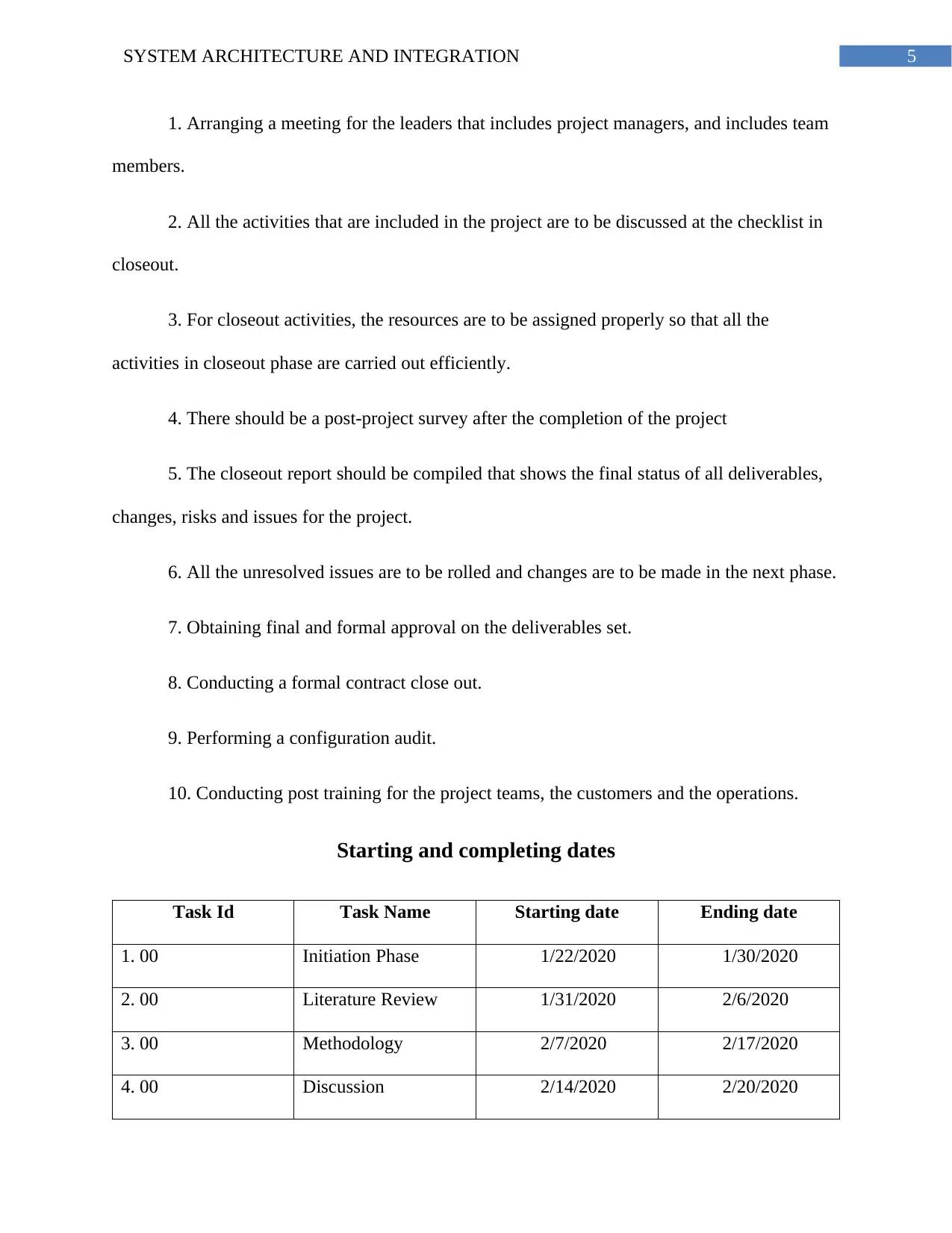
5SYSTEM ARCHITECTURE AND INTEGRATION
1. Arranging a meeting for the leaders that includes project managers, and includes team
members.
2. All the activities that are included in the project are to be discussed at the checklist in
closeout.
3. For closeout activities, the resources are to be assigned properly so that all the
activities in closeout phase are carried out efficiently.
4. There should be a post-project survey after the completion of the project
5. The closeout report should be compiled that shows the final status of all deliverables,
changes, risks and issues for the project.
6. All the unresolved issues are to be rolled and changes are to be made in the next phase.
7. Obtaining final and formal approval on the deliverables set.
8. Conducting a formal contract close out.
9. Performing a configuration audit.
10. Conducting post training for the project teams, the customers and the operations.
Starting and completing dates
Task Id Task Name Starting date Ending date
1. 00 Initiation Phase 1/22/2020 1/30/2020
2. 00 Literature Review 1/31/2020 2/6/2020
3. 00 Methodology 2/7/2020 2/17/2020
4. 00 Discussion 2/14/2020 2/20/2020
1. Arranging a meeting for the leaders that includes project managers, and includes team
members.
2. All the activities that are included in the project are to be discussed at the checklist in
closeout.
3. For closeout activities, the resources are to be assigned properly so that all the
activities in closeout phase are carried out efficiently.
4. There should be a post-project survey after the completion of the project
5. The closeout report should be compiled that shows the final status of all deliverables,
changes, risks and issues for the project.
6. All the unresolved issues are to be rolled and changes are to be made in the next phase.
7. Obtaining final and formal approval on the deliverables set.
8. Conducting a formal contract close out.
9. Performing a configuration audit.
10. Conducting post training for the project teams, the customers and the operations.
Starting and completing dates
Task Id Task Name Starting date Ending date
1. 00 Initiation Phase 1/22/2020 1/30/2020
2. 00 Literature Review 1/31/2020 2/6/2020
3. 00 Methodology 2/7/2020 2/17/2020
4. 00 Discussion 2/14/2020 2/20/2020
⊘ This is a preview!⊘
Do you want full access?
Subscribe today to unlock all pages.

Trusted by 1+ million students worldwide
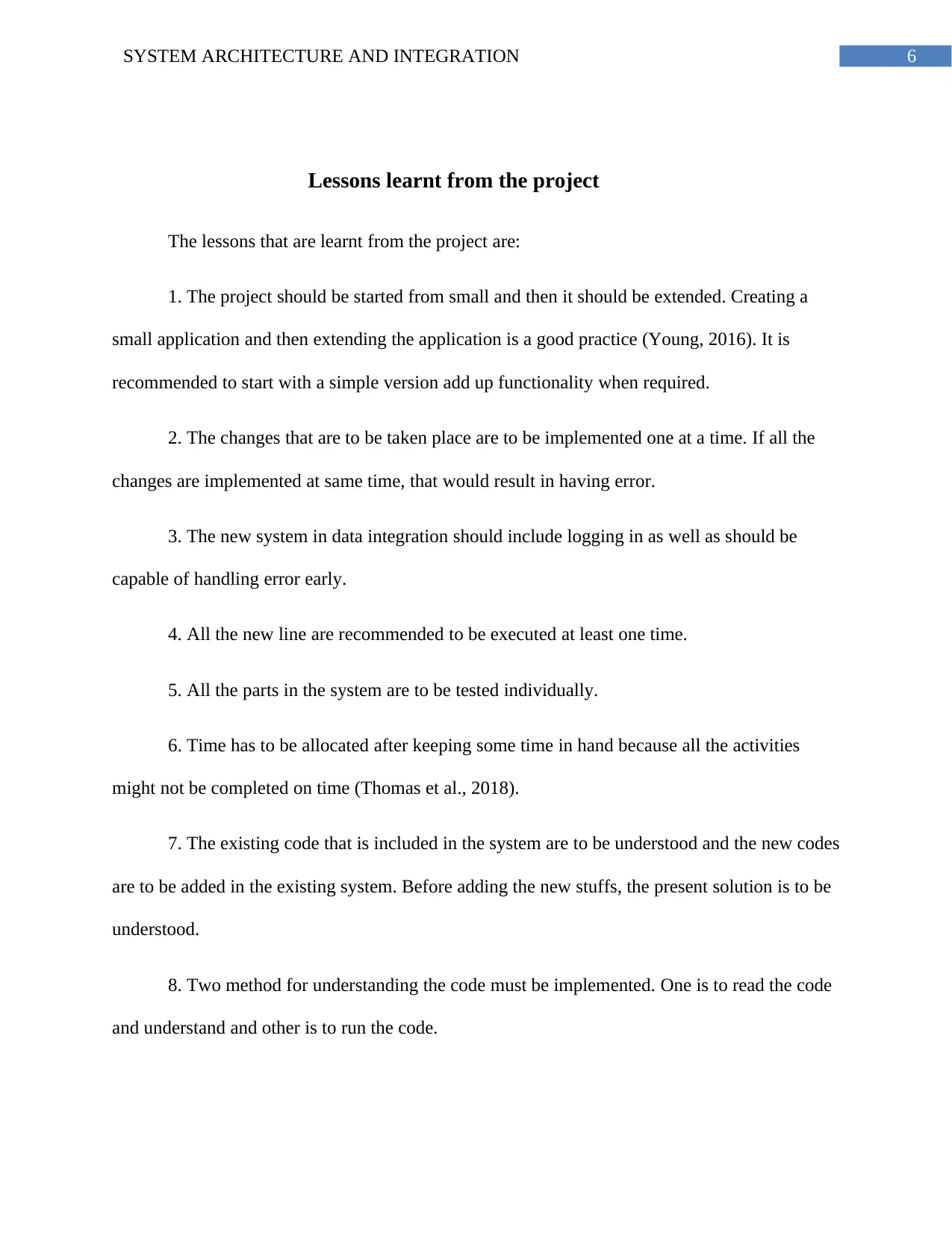
6SYSTEM ARCHITECTURE AND INTEGRATION
Lessons learnt from the project
The lessons that are learnt from the project are:
1. The project should be started from small and then it should be extended. Creating a
small application and then extending the application is a good practice (Young, 2016). It is
recommended to start with a simple version add up functionality when required.
2. The changes that are to be taken place are to be implemented one at a time. If all the
changes are implemented at same time, that would result in having error.
3. The new system in data integration should include logging in as well as should be
capable of handling error early.
4. All the new line are recommended to be executed at least one time.
5. All the parts in the system are to be tested individually.
6. Time has to be allocated after keeping some time in hand because all the activities
might not be completed on time (Thomas et al., 2018).
7. The existing code that is included in the system are to be understood and the new codes
are to be added in the existing system. Before adding the new stuffs, the present solution is to be
understood.
8. Two method for understanding the code must be implemented. One is to read the code
and understand and other is to run the code.
Lessons learnt from the project
The lessons that are learnt from the project are:
1. The project should be started from small and then it should be extended. Creating a
small application and then extending the application is a good practice (Young, 2016). It is
recommended to start with a simple version add up functionality when required.
2. The changes that are to be taken place are to be implemented one at a time. If all the
changes are implemented at same time, that would result in having error.
3. The new system in data integration should include logging in as well as should be
capable of handling error early.
4. All the new line are recommended to be executed at least one time.
5. All the parts in the system are to be tested individually.
6. Time has to be allocated after keeping some time in hand because all the activities
might not be completed on time (Thomas et al., 2018).
7. The existing code that is included in the system are to be understood and the new codes
are to be added in the existing system. Before adding the new stuffs, the present solution is to be
understood.
8. Two method for understanding the code must be implemented. One is to read the code
and understand and other is to run the code.
Paraphrase This Document
Need a fresh take? Get an instant paraphrase of this document with our AI Paraphraser
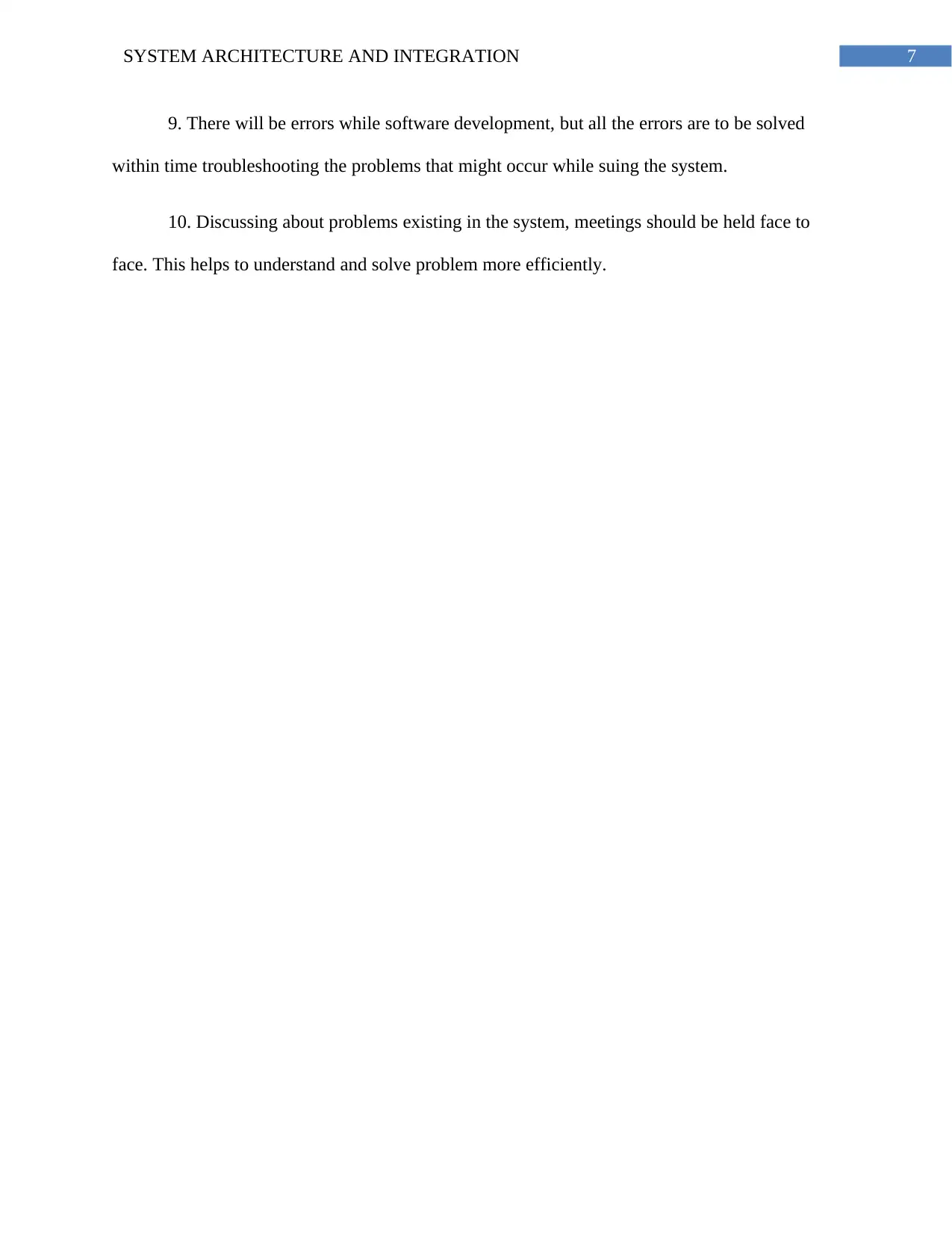
7SYSTEM ARCHITECTURE AND INTEGRATION
9. There will be errors while software development, but all the errors are to be solved
within time troubleshooting the problems that might occur while suing the system.
10. Discussing about problems existing in the system, meetings should be held face to
face. This helps to understand and solve problem more efficiently.
9. There will be errors while software development, but all the errors are to be solved
within time troubleshooting the problems that might occur while suing the system.
10. Discussing about problems existing in the system, meetings should be held face to
face. This helps to understand and solve problem more efficiently.
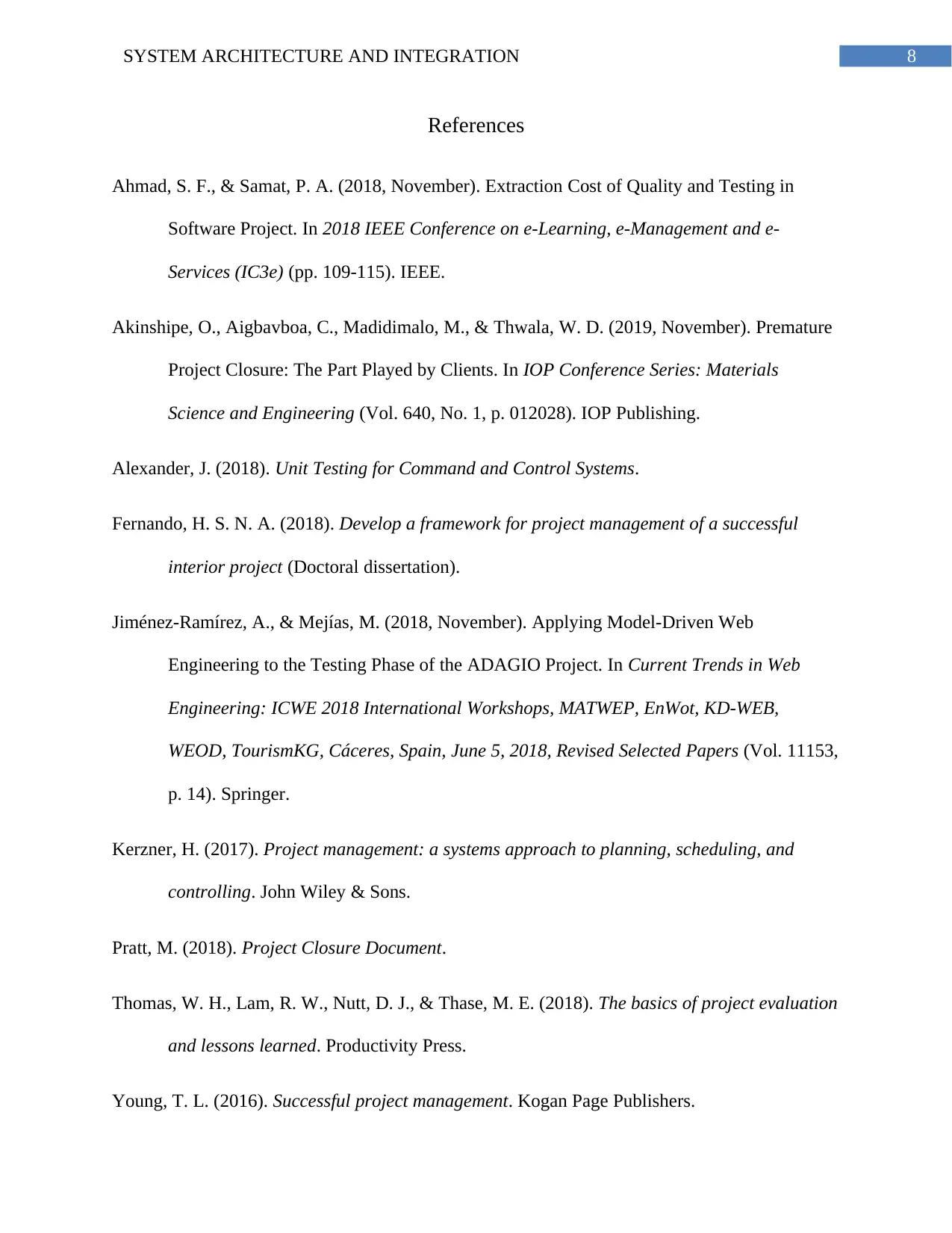
8SYSTEM ARCHITECTURE AND INTEGRATION
References
Ahmad, S. F., & Samat, P. A. (2018, November). Extraction Cost of Quality and Testing in
Software Project. In 2018 IEEE Conference on e-Learning, e-Management and e-
Services (IC3e) (pp. 109-115). IEEE.
Akinshipe, O., Aigbavboa, C., Madidimalo, M., & Thwala, W. D. (2019, November). Premature
Project Closure: The Part Played by Clients. In IOP Conference Series: Materials
Science and Engineering (Vol. 640, No. 1, p. 012028). IOP Publishing.
Alexander, J. (2018). Unit Testing for Command and Control Systems.
Fernando, H. S. N. A. (2018). Develop a framework for project management of a successful
interior project (Doctoral dissertation).
Jiménez-Ramírez, A., & Mejías, M. (2018, November). Applying Model-Driven Web
Engineering to the Testing Phase of the ADAGIO Project. In Current Trends in Web
Engineering: ICWE 2018 International Workshops, MATWEP, EnWot, KD-WEB,
WEOD, TourismKG, Cáceres, Spain, June 5, 2018, Revised Selected Papers (Vol. 11153,
p. 14). Springer.
Kerzner, H. (2017). Project management: a systems approach to planning, scheduling, and
controlling. John Wiley & Sons.
Pratt, M. (2018). Project Closure Document.
Thomas, W. H., Lam, R. W., Nutt, D. J., & Thase, M. E. (2018). The basics of project evaluation
and lessons learned. Productivity Press.
Young, T. L. (2016). Successful project management. Kogan Page Publishers.
References
Ahmad, S. F., & Samat, P. A. (2018, November). Extraction Cost of Quality and Testing in
Software Project. In 2018 IEEE Conference on e-Learning, e-Management and e-
Services (IC3e) (pp. 109-115). IEEE.
Akinshipe, O., Aigbavboa, C., Madidimalo, M., & Thwala, W. D. (2019, November). Premature
Project Closure: The Part Played by Clients. In IOP Conference Series: Materials
Science and Engineering (Vol. 640, No. 1, p. 012028). IOP Publishing.
Alexander, J. (2018). Unit Testing for Command and Control Systems.
Fernando, H. S. N. A. (2018). Develop a framework for project management of a successful
interior project (Doctoral dissertation).
Jiménez-Ramírez, A., & Mejías, M. (2018, November). Applying Model-Driven Web
Engineering to the Testing Phase of the ADAGIO Project. In Current Trends in Web
Engineering: ICWE 2018 International Workshops, MATWEP, EnWot, KD-WEB,
WEOD, TourismKG, Cáceres, Spain, June 5, 2018, Revised Selected Papers (Vol. 11153,
p. 14). Springer.
Kerzner, H. (2017). Project management: a systems approach to planning, scheduling, and
controlling. John Wiley & Sons.
Pratt, M. (2018). Project Closure Document.
Thomas, W. H., Lam, R. W., Nutt, D. J., & Thase, M. E. (2018). The basics of project evaluation
and lessons learned. Productivity Press.
Young, T. L. (2016). Successful project management. Kogan Page Publishers.
⊘ This is a preview!⊘
Do you want full access?
Subscribe today to unlock all pages.

Trusted by 1+ million students worldwide

9SYSTEM ARCHITECTURE AND INTEGRATION
Zohrehvandi, S., Khalilzadeh, M., Hajizadeh, M., & Cheraghi, E. (2017). Planning project
closure phase in combined cycle power plant projects. Procedia computer science, 121,
274-281.
Zohrehvandi, S., Khalilzadeh, M., Hajizadeh, M., & Cheraghi, E. (2017). Planning project
closure phase in combined cycle power plant projects. Procedia computer science, 121,
274-281.
1 out of 10
Related Documents
Your All-in-One AI-Powered Toolkit for Academic Success.
+13062052269
info@desklib.com
Available 24*7 on WhatsApp / Email
![[object Object]](/_next/static/media/star-bottom.7253800d.svg)
Unlock your academic potential
Copyright © 2020–2025 A2Z Services. All Rights Reserved. Developed and managed by ZUCOL.





